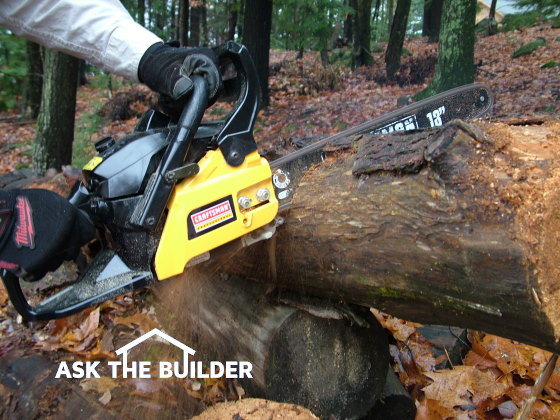Chainsaw

This lightweight chainsaw is really amazing. You would think it's a toy when you pick it up, but it chews through oak logs like they were butter. PHOTO CREDIT: Brent Walter
DEAR TIM: I need a chainsaw and am flummoxed as to which type to purchase. I'm certain that I want a gas chainsaw, but wonder whether to get an 18-inch chainsaw or a 14-inch model. I've never used chainsaws before and am concerned about my safety. Can an average person use one with little fear? What tips can you offer about buying and working with these amazing tools? Laurel S., Lusby, MD
DEAR LAUREL: I can sure see why you are overwhelmed when faced with purchasing a chainsaw. Wow! There are so many brands, models and features, it's tough to separate what is really needed to do a particular job. But the good news is that I can help you as I just went through this myself. However, it's impossible to share all the knowledge you need to know in this short column.
Many moons ago, 414 to be precise, I used to operate a chainsaw regularly. My father-in-law owned a large tract of forested land that we harvested wild cherry trees for both woodworking and firewood. I used a durable chainsaw that had an 18-inch bar. This saw was fairly heavy, and it cut through hardwood trees with little or no effort.
I was never injured by the chainsaw, but my father-in-law was seriously hurt one day. He slipped while using it and proceeded to make a deep cut in one of his legs. Accidents happen, but this one may have been prevented had he been wearing chainsaw chaps. Chaps are special protective clothing that is an absolute must to have. Furthermore you need heavy gloves, safety glasses and a helmet with a cutting shield.
You can work with these magnificent and powerful tools safely. I urge you to inquire about training classes or demonstrations that might be offered at local stores that sell the chainsaws. There are also some excellent video and DVD products that many of the chainsaw manufacturers have produced that take you through a safety course. These mission-critical safety lessons must not be skipped.
I now own a fantastic 2.4 cubic inch, 40/cc two-cycle gasoline chainsaw that has an 18-inch bar. It's a Sears Craftsman, but as with all things Sears, it's made by some other manufacturer. Sears doesn't own a factory. They sell things made by other companies. I believe this saw was made by Husqvarna, but I'm not certain.
When I first took the saw out of the box I was disappointed. The saw was so light that I thought it was a toy. As soon as I started it and began to use it, I changed my mind. This saw is a beauty. The saw I used over 30 years ago was much heavier, and it would create arm fatigue before the rest of my body was tired. Pay attention to weight as well as any features on the saws that lessen vibrations.
When selecting a chainsaw, think long and hard about what you will really be cutting. In my opinion, you want a chainsaw that has a bar that's longer than the diameter of the wood you will be cutting. You absolutely can cut logs that have a diameter larger than the bar is long, but you take risks doing this.
Price is also a great indicator of quality. Chainsaws that cost more tend to have better parts and components, and they usually are more rugged. The extra money you spend will almost always give you a saw that will not let you down, and it can last generations if cared for. If you want recommendations about great chainsaws, talk to the owners of tree-trimming companies. They use the saws each workday and know what brands are dependable.
Cutting logs is a science. Be aware that a freshly cut tree has enormous amounts of tension in it as it lays on the ground. You can easily get the chainsaw bound up in a cut as the tree pinches the blade. Large portions of the tree can start to roll and trap you as you cut. You must always be aware of these dangers.
Be sure to read the owner's manual several times. Never take shortcuts with respect to the gas and oil that must be used. The bar needs oil to lubricate the moving chain. Use high-quality gas and oil for top performance.
Never let a chainsaw blade touch the ground or dirt. This will dull the blade very quickly. Cutting with a dull blade is both dangerous and puts lots of stress on the engine. Watch for dirt that gets trapped in the bark of older logs that you might find in the woods.
Sharpening a chainsaw blade is an art. The teeth of the blade must be ground to a precise angle to ensure the chainsaw cuts straight. Many tool-rental businesses will do a great job of sharpening chains. Don't underestimate this aspect of chainsaw maintenance.
Follow the instructions in the owner's manual for long-term storage if you want the saw to start after months of sitting idle. If you ignore these steps, you will be taking your saw in to get service.
Read about getting this chainsaw in the October 28, 2008 Newsletter.
Column 753
One Response to Chainsaw